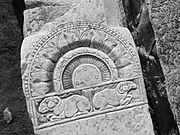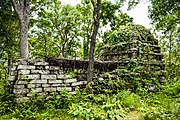Devunigutta Temple
| Devunigutta Temple | |
|---|---|
 Devunigutta Temple, north and west sides, c. 2017 | |
| Location | Jayashankar Bhupalpally district, Telangana, India |
| Coordinates | 18°6′54.6″N 80°02′13.3″E / 18.115167°N 80.037028°E |
| Built | 6th century CE[1] |
| Architectural style(s) | Hindu temple architecture |

The Devunigutta Temple ("God’s hill" in Telugu[2]) or Shiva Temple, Kothur is a Hindu temple near Kothur village in the Mulugu District, Telangana, India, some 60 km east of Warangal.[3][1][4] Located in a remote forested plateau, it was probably built c. 6th century CE by the Vakatakas.[2] It was first recorded in 2012, in an abandoned state, by the Archaeological Survey of India (ASI);[3] however, it did not come to wider attention until images were posted on social media in 2017.
The temple now consists of a square sanctuary with a shikhara or vimana tower,[5] with the sanctuary open to the interior of the tower, and a low wall enclosing an entrance court. An unusual profusion of relief sculptures, though very worn, are located both inside and outside.[6][2] Visiting international scholars, as well as local people, have expressed concern about the condition of the building. Local voluntary groups cleared the vegetation growing on the actual structure,[7] although by 2020 much had regrown. In late 2019 the Archaeological Survey of India was ready to restore the temple, but was awaiting permission from the local authorities.[8]
An image of
Rediscovery
Although apparently reported to the ASI in 2012,[3] the temple attracted little attention until photographs were posted on social media in 2017.[2] An Assistant Director of Archaeology and Museums for Telangana state visited the temple in August 2017, and "submitted a report stressing the need to conserve the temple", but as of early 2019 no action had been taken.[9]
A German art historian, Corinna Wessels-Mevissen, who saw the temple in 2018, said “The temple is a unique blend of styles visible in Udayagiri and Scandagiri in Odisha and also a bit of Amaravati like (Andhra Pradesh) architecture.”[10][11]

A British expert, Adam Hardy, who visited the temple in 2019, described it as "a unique temple with a rare architecture full of imagery and a depiction of a heavenly vision in sculpture", though he dismissed claims of resemblance to Angkor Wat, saying Devunigutta was in any case older, probably from the 6th century.[12] He was reported as saying "It’s high time the Archaeological Department take the necessary steps to protect the temple which is beginning to collapse."[13]
Corinna Wessels-Mevissen gave a brief report on the temple to a conference in Naples in 2018, and she and Adam Hardy published a paper on it in 2019.[14] Laxshmi Greaves, a colleague of Hardy at Cardiff University, visited the temple separately in 2018, and published an account.[3]
Architecture
The temple has a single enclosed space, about 6 metres square, and now 7 metres high; it is missing the kalasha urn or amalaka that would once have topped it. It is built of blocks of sandstone that have eroded considerably. The blocks are closely fitted, but there are traces of mortar, and a few of reddish stucco, which probably originally covered all the reliefs, and may have been painted.[15] Apart from erosion of the stone, the temple seems generally well-preserved, apart from damage above the entrance and a "long vertical cleft" running down the west wall, which has disrupted the left side of the exterior relief panel with Ardhanarishvara (illustrated).[16] The low wall marking an enclosure in front of the temple is probably not original,[17] and is rather crudely constructed of similar blocks, perhaps originally used for another structure.
A very unusual feature in Hindu temple architecture is that the sanctuary has no ceiling, and visitors can look straight up inside the corbelled shikara/vimana. This is a feature shared with the Gop Temple of about 550 on the other side of India in Gujarat.[18] Usually the flat and unornamented ceiling of the sanctuary is an essential part of the "cave and mountain" architectural metaphor of a Hindu temple. This may relate to apparently wooden temples with octagonal towers seen in some Buddhist reliefs.[19] Wessels-Mevissen and Hardy conclude the temple's "unique architecture provides a missing link between early timber structures and the Dråvida tradition".[2]

The tower has four tiers, "defined by relief-encrusted
Inside there is now a modern plinth holding an image of Narashima, but no sign of a lingam, nor of a drainage channel for offerings.[15] Local people say a lingam was stolen some time ago.[3]
Leaning against the wall of the enclosed courtyard are three white limestone fragments, one of which appears to be a post from a carved railing typical of Buddhist stupas (for example Amaravati Stupa, though these are much larger), although no stupas are known to have existed within 100 km of the temple. They may have been brought to the site as a source of lime for the mortar, or to decorate it.[20]
Reliefs
Reliefs carved into the structural blocks cover "almost every available surface", both inside and out.[15] Though early press reports dwelled on Buddhist-like aspects of the temple, it is clearly a Hindu temple dedicated to Shiva, who appears prominently in the composite form of Ardhanarishvara, divided between his male form and the female one of Parvati, his consort. Ardhanarishvara appears centrally on the reliefs on both the inside and outside of the rear (west) wall of the sanctuary, a feature not known elsewhere.[21]

The large relief groups "exhibit a homogenous sculptural style essentially reminiscent of Gupta art and other sculptural idioms present in this early period"[15] although the site is a long way from areas controlled by the Gupta Empire by the 460s. They are crowded with figures, above all the very large group occupying the back wall of the sanctuary. The reliefs have many unusual iconographic features, and not all the subjects are yet clear.[3] Together they suggest "the spread of a pre-Tantric form of ascetic Saivism to the South of India".[22]
The three large exterior groups
The Ardhanarishvara group on the outside rear (east) wall has unusual features. Ardhanarishvara, though in a composite male/female form and much the largest figure, has a relatively large female figure on the viewer's left, perhaps a consort. A small elephant-headed
The large group on the exterior north wall probably shows Balarama defeating the evil asura Pralambasura, with his right arm raised to strike the fatal blow to the figure below him, whose head he holds, while his knee presses into his back. To the left of the panel two male worshippers are squatting. Around Balarama's head are four ayudhapurusha figures, personified divine weapons normally associated with Vishnu, a very unusual feature.[25]
The large group on the exterior south wall is "difficult to interpret". It probably shows Shiva in the "royal ease" position, flanked by a male and female figure, and with a dwarf kneeling below him. The male figure appears to touch Shiva's raised foot in a gesture of respect. Next to Shiva's head is another bovine head, and there are a number of other figures, including small flying attendants.[26] Greaves interprets this scene as "Śiva trampling on the demon of ignorance".[3]
Reliefs on the interior walls
Almost the whole of the inside west (rear) wall is occupied with a large relief, crowded with figures in three registers, but with "no apparent visual narrative [that] connects all these images". A large standing two-armed Ardhanarishvara is placed centrally at a low level, with Shiva and Parvati seated above, probably shown in their mountain home on
Other reliefs
The very many smaller reliefs on the exterior walls include, on the first upper level of the west wall, a group of
Other scenes and figures include loving couples (
-
The worn relief on the inside back (west) wall
-
Outside south wall group, probably Shiva and companions
-
Corinna Wessels-Mevissen examining the temple
-
The probable post from a carved railing of a Buddhist stupa, in the courtyard
-
Small heads on a higher level
-
From the front, 2020
Notes
- ^ a b Reddy, U. Sudhakar (28 January 2019). "Cardiff expert says no resemblance of Devunigutta architecture with Angkor Wat". The Times of India. Retrieved 5 January 2020.
- ^ a b c d e Wessels-Mevissen and Hardy, 265
- ^ a b c d e f g h i Greaves
- ^ "Telangana: Ancient Mulugu temple soon to become tourist attraction". Deccan Chronicle. 4 September 2017. Retrieved 5 January 2020.
- ^ "shikhara" to Greaves, "vimana" to Wessels-Mevissen and Hardy. At this locality and date, the northern and southern forms of tower over a sanctuary were just beginning to emerge
- ^ Greaves; Telangana Tourism
- ^ Telangana Tourism has photos before, during and after.
- ^ Newsmeter, "Devuni Gutta temple in Mulugu lies in state of neglect", by Dasari Sreenivasa Rao, 16 December 2019
- ^ Reddy, AuthorP Laxma. "Need to conserve Devunigutta temple: Archaeologists". Telangana Today. Retrieved 5 January 2020.
- ^ Telangana Today, "Need to conserve Devunigutta temple: Archaeologists", by P. Laxma Reddy, 24th Jan 2019
- ^ Reddy, AuthorP Laxma. "Art historian from Germany visits Devunigutta temple". Telangana Today. Retrieved 5 January 2020.
- Times of India, U Sudhakar Reddy, Jan 28, 2019
- ^ Mahender, Adepu (27 January 2019). "Devuni Gutta: A researcher's paradise". www.thehansindia.com. Retrieved 5 January 2020.
- ^ Greaves; Wessels-Mevissen and Hardy is the paper, which is based on the conference report
- ^ a b c d Wessels-Mevissen and Hardy, 267
- ^ Wessels-Mevissen and Hardy, 277
- ^ a b Wessels-Mevissen and Hardy, 268
- ^ Wessels-Mevissen and Hardy, 267–268
- ^ Wessels-Mevissen and Hardy, 269
- ^ Wessels-Mevissen and Hardy, 269; there are photos in Telangana Tourism.
- ^ Wessels-Mevissen and Hardy, 275; Greaves
- ^ Wessels-Mevissen and Hardy, 276
- ^ Wessels-Mevissen and Hardy, 269–271
- ^ Wessels-Mevissen and Hardy, 270; Greaves (also for photos)
- ^ a b Wessels-Mevissen and Hardy, 272; Greaves (also for photos)
- ^ Wessels-Mevissen and Hardy, 272–274, 272 quoted; Greaves (also for photos)
- ^ Wessels-Mevissen and Hardy, 273–276; Greaves (also for photos)
- ^ Wessels-Mevissen and Hardy, 272; Greaves (also for photos); photo of the Badami group.
References
All these have many good photos.
- Greaves, Laxshmi Rose, "Devunigutta: A Recently Discovered 6th Century Temple in Telangana", Art of South Asia, 2019
- "Telangana Tourism": "Reconstruction of Devuni Gutta Temple, Kothur village" Archived 12 November 2022 at the Wayback Machine, Feature on Telangana Tourism website
- Wessels-Mevissen, Corinna, and Hardy, Adam, "Note on a Recently Reported Early Śiva Temple near Kothur (Telangana State)", Berlin Indological Studies, 24 (2019): 265–278








